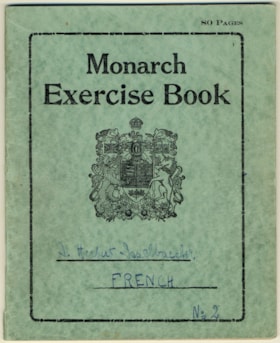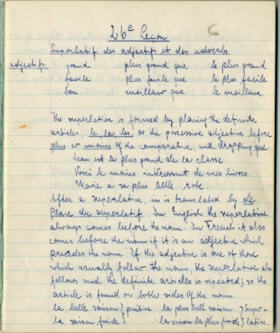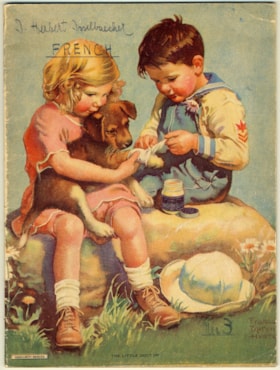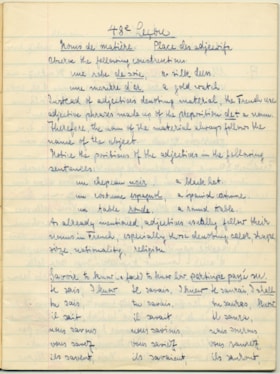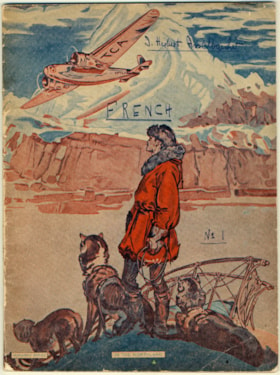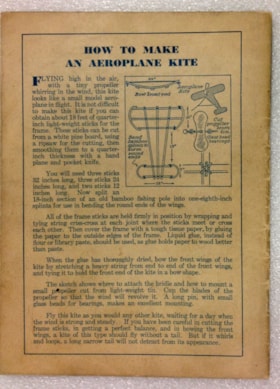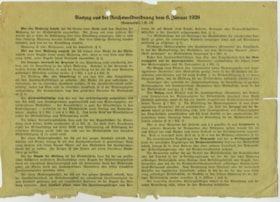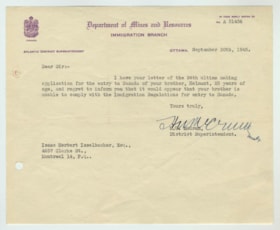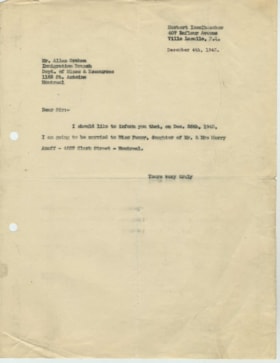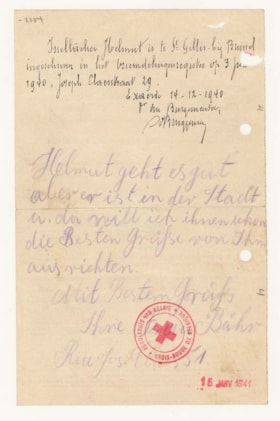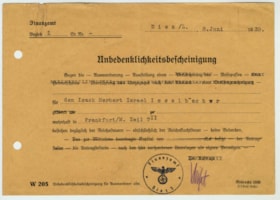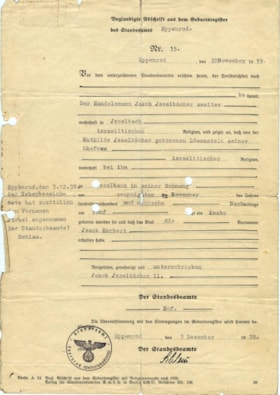Narrow Results By
Collection
- Aline Gubbay Fonds 1
- Allan Raymond Collection 13
- CONGREGATION AGUDATH ACHIM, Sherbrooke, Quebec. 1
- CONGREGATION SHAAR HASHOMAYIM MUSEUM AND ARCHIVES 1
- Canadian Jewish Congress organizational records 58
- Canadian Jewish Military Casualties 1
- Dr. Herbert H. Cosman fonds 1
- Echenberg Family Fonds 1
- HEBREW SICK BENEFIT ASSOCIATION 8
- Hans Reiche fonds 9
- Hebrew Sick Benefit Association Membership Form 8
- Judge Jacie C. Horwitz fonds 4
Name
- 1 brother 1
- 1 daughter 1
- 1 son; 3 married daughters; 15 grandchildren 1
- 1 son; 4 daughters; 8 grandchildren 1
- 2 sons 1
- 2 sons, 1 married, both lives in New York; 1 daughter in New York 1
- 3 married daughters; 3 single daughters; 5 grandchildren 1
- 3 sons 2
- 3 sons; 2 daughters 1
- 3 sons; 2 married daughters 1
- 3 sons; 3 daughters 2
- 4 sons, 2 are married; Mrs. Louis Hedner, Sherbrooke; Mrs. V. Zinman (Sarah) 1
Place
- Ahavath Sholem Shul Cemetery 1
- Austria 2
- Bacharach am Rhein, Germany, Europe 1
- Bacharach, Germany, Europe 3
- Bayeux Memorial 1
- Bellevue Hospital, New York 1
- Beth Yehuda Shul Cemetery 1
- B'nai Jacob Cemetery, Montreal 1
- Brussels, Belgium, Europe 2
- Calvados, France 1
- Canada, North America 2
- Chevra Shas Cemetery 1
Subject
- $1,000 remittance from Sherbrooke 1
- $1900 received from Sherbrooke; $718 from Prince Albert 1
- Annual campaign meeting of Sherbrooke community - Rabbi Wilfred Shuchat 1
- A. S. MITLEMAN 1
- Buildings 10
- Buildings (Montreal) 10
- Campaign 3
- Campaign contributions from Congregation Agudath Achim, Sherbrooke Quebec 1
- Campaign in Sherbrooke 1
- Campaign meeting in Sherbrooke - Rabbi Jesse Schwartz 1
- Campaign receipts - Sherbrooke 1
- Campaign receipts - Sherbrooke and Edmonton 1
Curriculum Vitae
https://www.cjhn.ca/link/cjhn45485
- Collection
- Montreal Holocaust Museum
- Description Level
- Item
- Material Type
- textual record
- Physical Description
- Curriculum Vitae : Paper : typed, handwritten : Ink : beige, black ; Ht: 28 cm x W: 21 cm
- Date
- 1945
- Collection
- Montreal Holocaust Museum
- Description Level
- Item
- Material Type
- textual record
- Physical Description
- Curriculum Vitae : Paper : typed, handwritten : Ink : beige, black ; Ht: 28 cm x W: 21 cm
- Other Title Information
- Documentary Artifact
- Date
- 1945
- Physical Condition
- Good
- Language
- English
- Notes
- Paper with two holes punched on left edge, creased once horizontally and three times vertically, signed by hand, with minor additions in pencil. Curriculum vitae of Isaac Herbert Isselbaecher detailing his departure from Germany, his employment history in England, and the dates of his emigration. He provides four references: a cousin and three uncles, all living in New York City. Narrative: Isaac Herbert Isselbacher was born 1919-11-20 in Isselbach, Germany. His brother was Helmut Isselbacher, born 1921-12-20. Their father was Jacob Isselbacher, born 1883-08-05. They had an uncle and aunt, David and Betty Loewenstein, who lived in New York City with their two children. Isaac left Germany on 1939-07-29, hoping to join his relatives in NYC. He only had the time to get to London, England before the war broke out and started working in a factory. He was arrested at his workplace as an ‘enemy alien’ and sent to Canada for internment in 1940. Isaac was interned in Camp N in Sherbrooke, Quebec. He was drafted into the Works Program Division for woodworking and net-making. In 1940, he received a last letter from his parents which suggested their imminent deportation. After his release, circa November 1942, Isaac worked as a locksmith. He married Fanny Azeff on 1943-12-26 at the Bnai Jacob synagogue in Montreal. Fanny was born on 1921-12-23 in Canada, the daughter of Mr. and Mrs. Harry Azeff. Isaac was naturalized as a Canadian citizen on 1946-06-08. Fanny was naturalized on 1946-08-30 (she had lost her citizenship by marrying Isaac). Upon learning of his brother’s survival, Isaac travelled to New York in April 1946 to meet with him and their Loewenstein relatives. Afterwards, Helmut travelled to Canada bringing with him a washing machine and bras as late wedding presents for his brother and Fanny. By 1946-08-12, their parents were presumed dead and the two sons inquired into their estate. They received a deed for the land and travelled to the estate to discover that the current owner of their house was their old maid and her son had become the town mayor. Various disputes arose with the current ‘owners’ who believed the Isselbacher family dead. Isaac wished to discuss a settlement, but the mayor’s mother –not realizing Fanny understood German- called the neighbours at work to warn them not to come home as the Isselbacher sons had resurfaced. Payment for the land had reportedly been sent to Israel, though no documentation could be provided.
- Accession No.
- 1999.01.26
- Name Access
- Issley, Jason
- Archival / Genealogical
- Archival Descriptions
- Repository
- Montreal Holocaust Museum
Images
Monarch Exercise Book
https://www.cjhn.ca/link/cjhn47848
- Collection
- Montreal Holocaust Museum
- Description Level
- Item
- Material Type
- textual record
- Physical Description
- Notebook : bound, handwritten, graphic arts : green, black, beige, blue, red ; Ht: 21 cm x W: 17,1 cm
- Date
- January 12, 1942-February 15, 1942
- Collection
- Montreal Holocaust Museum
- Description Level
- Item
- Material Type
- textual record
- Physical Description
- Notebook : bound, handwritten, graphic arts : green, black, beige, blue, red ; Ht: 21 cm x W: 17,1 cm
- Other Title Information
- Documentary Artifact
- Date
- January 12, 1942-February 15, 1942
- Physical Condition
- Excellent
- Language
- English
- French
- Notes
- 80 pages. Softcover, paper bound with stables. Cover has a marbled green effect with a black title surrounded by a beveled edge border. There is a coat of arms in the centre of the cover, with 2 lines with handwritten information (see inscription). Back cover has addition, multiplication and arithmetical tables. Interior pages are beige, with printed horizontal blue lines and vertical red border lines; consisting of handwritten exercises in blue and black ink, with corrections made in red pencil. Narrative: Used in internment camp in Quebec. Mr. Herbert Isaak used this French exercise book to practise writing French as he studied for the Quebc High School Diploma.Herbert left Germany at the end of July 1939 and entered England with a trainee permit. He registered with the Jewish Refuge committee and a tribunal ruled that he was a refugee from Nazi oppression. On July 13th 1940, Herbert entered Canada, and was placed in Camp N, in Sherbrooke, Quebec.
- Accession No.
- 1999.01.882
- Name Access
- Issley, Jason
- Archival / Genealogical
- Archival Descriptions
- Repository
- Montreal Holocaust Museum
Images
Notebook
https://www.cjhn.ca/link/cjhn47849
- Collection
- Montreal Holocaust Museum
- Description Level
- Item
- Material Type
- textual record
- Physical Description
- Notebook : bound, handwritten, graphic arts : blue, beige, pink, brown, yellow, white, green, red ; Ht: 24,1 cm x W: 18,2 cm
- Date
- -March 10, 1942
- Collection
- Montreal Holocaust Museum
- Description Level
- Item
- Material Type
- textual record
- Physical Description
- Notebook : bound, handwritten, graphic arts : blue, beige, pink, brown, yellow, white, green, red ; Ht: 24,1 cm x W: 18,2 cm
- Other Title Information
- Documentary Artifact
- Date
- -March 10, 1942
- Physical Condition
- Excellent
- Language
- English
- French
- Notes
- 52 pages. softcover, paper bound with staples. Front cover has a colour painting of 2 children (boy and girl) bandaging a puppy's paw. Title handwritten in blue ink (see inscription). Back cover is beige with a "Safety First" admonition for children. Interior pages are beige, with printed horizontal blue lines and vertical red border lines; consisting of handwritten exercises in blue and black ink, with corrections made in red pencil. A page of lined beige paper has been inserted with another exercise in the same handwriting, also with corrections made in red pencil. Narrative: Used in internment camp in Quebec. Mr. Herbert Isaak used this French exercise book to practise writing French as he studied for the Quebec High School Diploma. Herbert left Germany at the end of July 1939 and entered England with a trainee permit. He registered with the Jewish Refuge committee and a tribunal ruled that he was a refugee from Nazi oppression. On July 13th 1940, Herbert entered Canada, and was placed in Camp N, in Sherbrooke, Quebec.
- Accession No.
- 1999.01.883
- Name Access
- Issley, Jason
- Archival / Genealogical
- Archival Descriptions
- Repository
- Montreal Holocaust Museum
Images
Notebook
https://www.cjhn.ca/link/cjhn47850
- Collection
- Montreal Holocaust Museum
- Description Level
- Item
- Material Type
- textual record
- Physical Description
- Notebook : bound, handwritten, graphic arts : red, brown, blue, white, black, beige ; Ht: 24 cm x W: 17,9 cm
- Date
- October 15, 1941-January 12, 1942
- Collection
- Montreal Holocaust Museum
- Description Level
- Item
- Material Type
- textual record
- Physical Description
- Notebook : bound, handwritten, graphic arts : red, brown, blue, white, black, beige ; Ht: 24 cm x W: 17,9 cm
- Other Title Information
- Documentary Artifact
- Date
- October 15, 1941-January 12, 1942
- Physical Condition
- Good
- Language
- English
- French
- Notes
- 52 pages. softcover, paper bound with staples. Front cover has a color drawing of a man in a red jacket with a dogsled team watching an airplane fly near a mountain. Handwritten title in blue ink (see inscriptions). Back cover is beige with blue text describing how to make an airplane kite, complete with diagram. Interior pages are beige, with printed horizontal blue lines and vertical red border lines; consisting of handwritten exercises in blue and black ink, with corrections made in red pencil. Narrative: Used in internment camp in Quebec. Mr. Herbert Isaak used this French exercise book to practise writing French as he studied for the Quebc High School Diploma. Herbert left Germany at the end of July 1939 and entered England with a trainee permit. He registered with the Jewish Refuge committee and a tribunal ruled that he was a refugee from Nazi oppression. On July 13th 1940, Herbert entered Canada, and was placed in Camp N, in Sherbrooke, Quebec.
- Accession No.
- 1999.01.885
- Name Access
- Issley, Jason
- Archival / Genealogical
- Archival Descriptions
- Repository
- Montreal Holocaust Museum
Images
Certificate
https://www.cjhn.ca/link/cjhn50168
- Collection
- Montreal Holocaust Museum
- Description Level
- Item
- Material Type
- textual record
- Physical Description
- Certificate : Paper : Black, Yellow, Purple ; Ht: 8 1/4 in. x W: 11 1/2 in.
- Date
- March 13, 1939
- Collection
- Montreal Holocaust Museum
- Description Level
- Item
- Material Type
- textual record
- Physical Description
- Certificate : Paper : Black, Yellow, Purple ; Ht: 8 1/4 in. x W: 11 1/2 in.
- Other Title Information
- Documentary Artifact
- Date
- March 13, 1939
- Physical Condition
- Poor
- Language
- German
- Notes
- 1 page, printed back and front. 10 colums. Stamp in the bottom right corner with the Reichsadler in the center. Document cancels the registration with police authorities prior to immigration. Narrative: Issued in Isselbach indicated that Herbert Isselbaecher moved from Iselbach to Frankfurt am Main on 13 March 1939. This document notified police authority of the intention to move. Soon after this on July 29th, 1939, Herbert left Germany, and entered England with a trainee permit. He registered with the Jewish Refuge committee, and the tribunal decided he was a refugee from Nazi oppression. On July 13th 1940, Herbert entered Canada, and was places in Camp N, in Sherbrooke, Quebec.
- Accession No.
- 1999.01.82
- Name Access
- Issley, Jason
- Places
- Isselbach, Germany, Europe
- Archival / Genealogical
- Archival Descriptions
- Repository
- Montreal Holocaust Museum
Images
Employment certificate
https://www.cjhn.ca/link/cjhn50320
- Collection
- Montreal Holocaust Museum
- Description Level
- Item
- Material Type
- textual record
- Physical Description
- Employment certificate : Paper : Ink : Purple, Black, Biege ; Ht: 5 3/4 in. x W: 8 1/4 in.
- Date
- April 29, 1939
- Collection
- Montreal Holocaust Museum
- Description Level
- Item
- Material Type
- textual record
- Physical Description
- Employment certificate : Paper : Ink : Purple, Black, Biege ; Ht: 5 3/4 in. x W: 8 1/4 in.
- Other Title Information
- Documentary Artifact
- Date
- April 29, 1939
- Physical Condition
- Good
- Language
- German
- Notes
- 1 page, one-sided. Circular ink stamp in the bottom left corner, with a Reichsadler in the middle of it. Certificate for Isack Herbert Isselbächer, finding him to be hard working. Narrative: Herbert left Germany at the end of July 1939 and entered England with a trainee permit. He registered with the Jewish Refuge committee and a tribunal ruled that he was a refugee from Nazi oppression.However, he was interned as an enemy alien in England, because of his German nationality. On July 13, 1940, Herbert entered Canada and was placed in Camp N, in Sherbrooke, Quebec.
- Accession No.
- 1999.01.86
- Name Access
- Issley, Jason
- Places
- Isselbach, Germany, Europe
- Archival / Genealogical
- Archival Descriptions
- Repository
- Montreal Holocaust Museum
Images
Letter
https://www.cjhn.ca/link/cjhn50321
- Collection
- Montreal Holocaust Museum
- Description Level
- Item
- Material Type
- textual record
- Physical Description
- Letter : Paper : Ink : Purple, Black ; Ht: 6,5 in. x W: 8 in.
- Date
- September 20, 1945
- Collection
- Montreal Holocaust Museum
- Description Level
- Item
- Material Type
- textual record
- Physical Description
- Letter : Paper : Ink : Purple, Black ; Ht: 6,5 in. x W: 8 in.
- Other Title Information
- Documentary Artifact
- Date
- September 20, 1945
- Physical Condition
- Good
- Language
- English
- Notes
- 1 page, one-sided. Canadian Coat of arms in the top left corner. Narrative: Letter of rejection from Canadian immigration office for Isaac Herbert Isselbacher to bring his brother Helmut to Canada. Isaac Herbert Isselbacher had left Germany at the end of July 1939 and entered England with a trainee permit. He registered with the Jewish Refuge committee and a tribunal ruled that he was a refugee from Nazi oppression.However, he was interned as an enemy alien in England, because of his German nationality. On July 13, 1940, Herbert entered Canada and was placed in Camp N, in Sherbrooke, Quebec.
- Accession No.
- 1999.01.66
- Name Access
- Issley, Jason
- Archival / Genealogical
- Archival Descriptions
- Repository
- Montreal Holocaust Museum
Images
Postcard
https://www.cjhn.ca/link/cjhn51238
- Collection
- Montreal Holocaust Museum
- Description Level
- Item
- Material Type
- textual record
- Physical Description
- Postcard : Paper : Ink; Pencil : Beige, Black, Green, Red, Blue ; Ht: 5,5 in. x W: 3,25 in.
- Date
- August 14, 1940
- Collection
- Montreal Holocaust Museum
- Description Level
- Item
- Material Type
- textual record
- Physical Description
- Postcard : Paper : Ink; Pencil : Beige, Black, Green, Red, Blue ; Ht: 5,5 in. x W: 3,25 in.
- Other Title Information
- Documentary Artifact
- Date
- August 14, 1940
- Physical Condition
- Good
- Language
- English
- German
- Notes
- 1 page, double-sided. On the verso there are 3 circular ink stamps, as well as a postal stamp with the portrait of Thomas Jefferson in top right corner. Postcard sent to Herbert Isselbaecher while in internment camp L in Québec city by his uncle Hugo Lowenstein. Ink stamps indicate that the content of the correspondence was screened by censors. Narrative: Isac Herbert Isselbacher was born 1919-11-20 in Isselbach, Germany. His brother was Helmut Isselbacher, born 1921-12-20. Their father was Jacob Isselbacher, born 1883-08-05. They had an uncle and aunt, David and Betty Loewenstein, who lived in New York City with their two children. Isac left Germany on 1939-07-29, hoping to join his relatives in NYC. He only had the time to get to London, England before the war broke out and started working in a factory. He was arrested at his workplace as an ‘enemy alien’ and sent to Canada for internment in 1940. Isac was interned in Camp N in Sherbrooke, Quebec. He was drafted into the Works Program Division for woodworking and net-making. In 1940, he received a last letter from his parents which suggested their imminent deportation. After his release, circa November 1942, Isac worked as a locksmith. He married Fanny Azeff on 1943-12-26 at the Bnai Jacob synagogue in Montreal. Fanny was born on 1921-12-23 in Canada, the daughter of Mr. and Mrs. Harry Azeff. Isac was naturalized as a Canadian citizen on 1946-06-08. Fanny was naturalized on 1946-08-30 (she had lost her citizenship by marrying Isac). Isac’s brother, Helmut Isselbacher, was deported with Transport XXII A from Caserne Dossin in Malines, Belgium to Auschwitz Birkenau, Poland on 1943-09-20. Of the 2,450 people on the transport, 100 men were selected to work –including Helmut- and the remainder prisoners were gassed. Helmut was made to work as a welder, and was soon fitting new pipes for the gas chamber. He suffered a nervous breakdown as a result. As he was a valued welder, he was transferred to a labour camp in Upper Silesia (Poland) where he remained for two years. As the Russian army advanced, the 6,000 prisoners of this camp were evacuated by train. Helmut remembered being forced to march as the other prisoners died from exhaustion. When liberation was announced, the survivors travelled by ship from Luebeck, Germany, to Sweden with the aid of the Red Cross. After recovery, Helmut decided to remain in Sweden as a welder. Upon learning of his brother’s survival, Helmut travelled to New York in April 1946 to meet with him and their Loewenstein relatives. Afterwards, Helmut travelled to Canada bringing with him a washing machine and bras as late wedding presents for his brother and Fanny. By 1946-08-12, their parents were presumed dead and the two sons inquired into their estate. They received a deed for the land and travelled to the estate to discover that the current owner of their house was their old maid and her son had become the town mayor. Various disputes arose with the current ‘owners’ who believed the Isselbacher family dead. Isac wished to discuss a settlement, but the mayor’s mother –not realizing Fanny understood German- called the neighbours at work to warn them not to come home as the Isselbacher sons had resurfaced. Payment for the land had reportedly been sent to Israel, though no documentation could be provided.
- Accession No.
- 1999.1.43
- Name Access
- Issley, Jason
- Archival / Genealogical
- Archival Descriptions
- Repository
- Montreal Holocaust Museum
Images
Invitation
https://www.cjhn.ca/link/cjhn51295
- Collection
- Montreal Holocaust Museum
- Description Level
- Item
- Material Type
- textual record
- Physical Description
- Invitation : Paper : Ink : Grey, Black ; Ht: 6,25 in. x W: 9 in.
- Date
- September 16, 1979
- Collection
- Montreal Holocaust Museum
- Description Level
- Item
- Material Type
- textual record
- Physical Description
- Invitation : Paper : Ink : Grey, Black ; Ht: 6,25 in. x W: 9 in.
- Other Title Information
- Documentary Artifact
- Date
- September 16, 1979
- Physical Condition
- Good
- Language
- English
- French
- Notes
- Rectangular, folded vertically in the middle. The cover has a barbwire illustration across the bottom, with two birds drawn in it.Invitation for the dedication of the Montreal Holocaust Memorial Centre. Announcing guest speaker Emil Fackenheim. Narrative: Guest speaker Emil Ludwig Fackenheim (1916-2003) was a Jewish philosopher and Reform rabbi. He was born in Halle, Germany and was arrested during the 1938 November pogroms (known as Kristallnacht). He was intenrned at the Sachsenhausen concentration camp until he escaped with his younger brother Wolfgang to Great Britain. Fackenheim was sent to Canada in 1940 as an "enemy alien" and interned at an internment camp near Sherbrooke, Quebec. After his release he served ad intermim Rabbi in Hamilton, Ontario (1943-1948). He received a Ph.D. from the University of Toronto with a dissertation on Medieval Arabic Philosophy (1945) and became Professor of Philosophy (1948–1984). He emigrated to Israel in 1984.
- Accession No.
- 2011X.58.213-214
- Name Access
- MHMC
- Archival / Genealogical
- Archival Descriptions
- Repository
- Montreal Holocaust Museum
Images
Police certificate
https://www.cjhn.ca/link/cjhn59327
- Collection
- Montreal Holocaust Museum
- Description Level
- Item
- Material Type
- textual record
- Physical Description
- Police certificate : Paper : Printed : Ink : Beige, green, purple ; Ht: 20,5 cm x W: 29 cm
- Date
- August 05, 1939
- Collection
- Montreal Holocaust Museum
- Description Level
- Item
- Material Type
- textual record
- Physical Description
- Police certificate : Paper : Printed : Ink : Beige, green, purple ; Ht: 20,5 cm x W: 29 cm
- Other Title Information
- Documentary Artifact
- Date
- August 05, 1939
- Physical Condition
- Good
- Language
- German
- Notes
- Printed form with details filled in by hand, perforated left edge, creased vertically down center, date stamp T.R., two holes punched in top, excerpt from Kingdom Report on back. Police Change-of-Address Form issued in Frankfurt indicates that Herbert Isaak Isselbaecher moved to London on 5 August 1939. Narrative: Isaac Herbert Isselbacher was born 1919-11-20 in Isselbach, Germany. His brother was Helmut Isselbacher, born 1921-12-20. Their father was Jacob Isselbacher, born 1883-08-05. They had an uncle and aunt, David and Betty Loewenstein, who lived in New York City with their two children. Isaac left Germany on 1939-07-29, hoping to join his relatives in NYC. He only had the time to get to London, England before the war broke out and started working in a factory. He was arrested at his workplace as an ‘enemy alien’ and sent to Canada for internment in 1940. Isaac was interned in Camp N in Sherbrooke, Quebec. He was drafted into the Works Program Division for woodworking and net-making. In 1940, he received a last letter from his parents which suggested their imminent deportation. After his release, circa November 1942, Isaac worked as a locksmith. He married Fanny Azeff on 1943-12-26 at the Bnai Jacob synagogue in Montreal. Fanny was born on 1921-12-23 in Canada, the daughter of Mr. and Mrs. Harry Azeff. Isaac was naturalized as a Canadian citizen on 1946-06-08. Fanny was naturalized on 1946-08-30 (she had lost her citizenship by marrying Isaac). Isaac’s brother, Helmut Isselbacher, was deported with Transport XXII A from Dossin casern in Mechelen (Mechelen (Malines)), Belgium to Auschwitz Birkenau, Poland on 1943-09-20. Of the 2,450 people on the transport, 100 men were selected to work –including Helmut- and the remainder prisoners were gassed. Helmut was made to work as a welder, and was soon fitting new pipes for the gas chamber. He suffered a nervous breakdown as a result. As he was a valued welder, he was transferred to a labour camp in Upper Silesia (Poland) where he remained for two years. As the Russian army advanced, the 6,000 prisoners of this camp were evacuated by train. Helmut remembered being forced to march as the other prisoners died from exhaustion. When liberation was announced, the survivors travelled by ship from Luebeck, Germany, to Sweden with the aid of the Red Cross. After recovery, Helmut decided to remain in Sweden as a welder. Upon learning of his brother’s survival, Helmut travelled to New York in April 1946 to meet with him and their Loewenstein relatives. Afterwards, Helmut travelled to Canada bringing with him a washing machine and bras as late wedding presents for his brother and Fanny. By 1946-08-12, their parents were presumed dead and the two sons inquired into their estate. They received a deed for the land and travelled to the estate to discover that the current owner of their house was their old maid and her son had become the town mayor. Various disputes arose with the current ‘owners’ who believed the Isselbacher family dead. Isaac wished to discuss a settlement, but the mayor’s mother –not realizing Fanny understood German- called the neighbours at work to warn them not to come home as the Isselbacher sons had resurfaced. Payment for the land had reportedly been sent to Israel, though no documentation could be provided.
- Accession No.
- 1999.1.83
- Name Access
- Issley, Jason
- Places
- Frankfurt, Germany, Europe
- Archival / Genealogical
- Archival Descriptions
- Repository
- Montreal Holocaust Museum
Images
Letter
https://www.cjhn.ca/link/cjhn59329
- Collection
- Montreal Holocaust Museum
- Description Level
- Item
- Material Type
- textual record
- Physical Description
- Letter : Paper : Typewritten : Ink : Beige, black ; Ht: 27,5 cm x W: 21 cm
- Date
- December 04, 1943
- Collection
- Montreal Holocaust Museum
- Description Level
- Item
- Material Type
- textual record
- Physical Description
- Letter : Paper : Typewritten : Ink : Beige, black ; Ht: 27,5 cm x W: 21 cm
- Other Title Information
- Documentary Artifact
- Date
- December 04, 1943
- Physical Condition
- Good
- Language
- English
- Notes
- Unsigned formal letter creased horizontally and vertically, addressed to Allan Graham from Herbert Isselbaecher. Informs the Department of Mines and Resources Immigration Branch of Herbert's upcoming marriage to Fanny Azeff on the 26 December, 1945. Narrative: Isaac Herbert Isselbacher was born 1919-11-20 in Isselbach, Germany. His brother was Helmut Isselbacher, born 1921-12-20. Their father was Jacob Isselbacher, born 1883-08-05. They had an uncle and aunt, David and Betty Loewenstein, who lived in New York City with their two children. Isaac left Germany on 1939-07-29, hoping to join his relatives in NYC. He only had the time to get to London, England before the war broke out and started working in a factory. He was arrested at his workplace as an ‘enemy alien’ and sent to Canada for internment in 1940. Isaac was interned in Camp N in Sherbrooke, Quebec. He was drafted into the Works Program Division for woodworking and net-making. In 1940, he received a last letter from his parents which suggested their imminent deportation. After his release, circa November 1942, Isaac worked as a locksmith. He married Fanny Azeff on 1943-12-26 at the Bnai Jacob synagogue in Montreal. Fanny was born on 1921-12-23 in Canada, the daughter of Mr. and Mrs. Harry Azeff. Isaac was naturalized as a Canadian citizen on 1946-06-08. Fanny was naturalized on 1946-08-30 (she had lost her citizenship by marrying Isaac). Isaac’s brother, Helmut Isselbacher, was deported with Transport XXII A from Dossin casern in Mechelen (Mechelen (Malines)), Belgium to Auschwitz Birkenau, Poland on 1943-09-20. Of the 2,450 people on the transport, 100 men were selected to work –including Helmut- and the remainder prisoners were gassed. Helmut was made to work as a welder, and was soon fitting new pipes for the gas chamber. He suffered a nervous breakdown as a result. As he was a valued welder, he was transferred to a labour camp in Upper Silesia (Poland) where he remained for two years. As the Russian army advanced, the 6,000 prisoners of this camp were evacuated by train. Helmut remembered being forced to march as the other prisoners died from exhaustion. When liberation was announced, the survivors travelled by ship from Luebeck, Germany, to Sweden with the aid of the Red Cross. After recovery, Helmut decided to remain in Sweden as a welder. Upon learning of his brother’s survival, Helmut travelled to New York in April 1946 to meet with him and their Loewenstein relatives. Afterwards, Helmut travelled to Canada bringing with him a washing machine and bras as late wedding presents for his brother and Fanny. By 1946-08-12, their parents were presumed dead and the two sons inquired into their estate. They received a deed for the land and travelled to the estate to discover that the current owner of their house was their old maid and her son had become the town mayor. Various disputes arose with the current ‘owners’ who believed the Isselbacher family dead. Isaac wished to discuss a settlement, but the mayor’s mother –not realizing Fanny understood German- called the neighbours at work to warn them not to come home as the Isselbacher sons had resurfaced. Payment for the land had reportedly been sent to Israel, though no documentation could be provided.
- Accession No.
- 1999.1.36
- Name Access
- Issley, Jason
- Archival / Genealogical
- Archival Descriptions
- Repository
- Montreal Holocaust Museum
Images
Letter
https://www.cjhn.ca/link/cjhn59330
- Collection
- Montreal Holocaust Museum
- Description Level
- Item
- Material Type
- textual record
- Physical Description
- Letter : Paper : Typewritten : Ink : Beige, red, black ; Ht: 21 cm x W: 13 cm
- Date
- April 30, 1941
- Collection
- Montreal Holocaust Museum
- Description Level
- Item
- Material Type
- textual record
- Physical Description
- Letter : Paper : Typewritten : Ink : Beige, red, black ; Ht: 21 cm x W: 13 cm
- Other Title Information
- Documentary Artifact
- Date
- April 30, 1941
- Physical Condition
- Good
- Language
- English
- Notes
- Half page, torn across bottom, two holes punched on left edge, censor stamp T.R.. This is a copy of a letter from the Staff Captain of the Prisoners of War Office in Hobart House, London. Addressed to an un-named Madame regarding the shipping of Isaac Isselbacher's personal effects from England with special attention to a Post Office Savings Book included in the luggage. Narrative: Isaac Herbert Isselbacher was born 1919-11-20 in Isselbach, Germany. His brother was Helmut Isselbacher, born 1921-12-20. Their father was Jacob Isselbacher, born 1883-08-05. They had an uncle and aunt, David and Betty Loewenstein, who lived in New York City with their two children. Isaac left Germany on 1939-07-29, hoping to join his relatives in NYC. He only had the time to get to London, England before the war broke out and started working in a factory. He was arrested at his workplace as an ‘enemy alien’ and sent to Canada for internment in 1940. Isaac was interned in Camp N in Sherbrooke, Quebec. He was drafted into the Works Program Division for woodworking and net-making. In 1940, he received a last letter from his parents which suggested their imminent deportation. After his release, circa November 1942, Isaac worked as a locksmith. He married Fanny Azeff on 1943-12-26 at the Bnai Jacob synagogue in Montreal. Fanny was born on 1921-12-23 in Canada, the daughter of Mr. and Mrs. Harry Azeff. Isaac was naturalized as a Canadian citizen on 1946-06-08. Fanny was naturalized on 1946-08-30 (she had lost her citizenship by marrying Isaac). Isaac’s brother, Helmut Isselbacher, was deported with Transport XXII A from Dossin casern in Mechelen (Malines), Belgium to Auschwitz Birkenau, Poland on 1943-09-20. Of the 2,450 people on the transport, 100 men were selected to work –including Helmut- and the remainder prisoners were gassed. Helmut was made to work as a welder, and was soon fitting new pipes for the gas chamber. He suffered a nervous breakdown as a result. As he was a valued welder, he was transferred to a labour camp in Upper Silesia (Poland) where he remained for two years. As the Russian army advanced, the 6,000 prisoners of this camp were evacuated by train. Helmut remembered being forced to march as the other prisoners died from exhaustion. When liberation was announced, the survivors travelled by ship from Luebeck, Germany, to Sweden with the aid of the Red Cross. After recovery, Helmut decided to remain in Sweden as a welder. Upon learning of his brother’s survival, Helmut travelled to New York in April 1946 to meet with him and their Loewenstein relatives. Afterwards, Helmut travelled to Canada bringing with him a washing machine and bras as late wedding presents for his brother and Fanny. By 1946-08-12, their parents were presumed dead and the two sons inquired into their estate. They received a deed for the land and travelled to the estate to discover that the current owner of their house was their old maid and her son had become the town mayor. Various disputes arose with the current ‘owners’ who believed the Isselbacher family dead. Isaac wished to discuss a settlement, but the mayor’s mother –not realizing Fanny understood German- called the neighbours at work to warn them not to come home as the Isselbacher sons had resurfaced. Payment for the land had reportedly been sent to Israel, though no documentation could be provided.
- Accession No.
- 1999.1.110
- Name Access
- Issley, Jason
- Places
- London, England, Europe
- Archival / Genealogical
- Archival Descriptions
- Repository
- Montreal Holocaust Museum
Images
Letter
https://www.cjhn.ca/link/cjhn59331
- Collection
- Montreal Holocaust Museum
- Description Level
- Item
- Material Type
- textual record
- Physical Description
- Letter : PaperPaper : Printed : Ink : Red, beige, black ; Ht: 21 cm x W: 14 cm
- Date
- November 07, 1940
- Collection
- Montreal Holocaust Museum
- Description Level
- Item
- Material Type
- textual record
- Physical Description
- Letter : PaperPaper : Printed : Ink : Red, beige, black ; Ht: 21 cm x W: 14 cm
- Other Title Information
- Documentary Artifact
- Date
- November 07, 1940
- Physical Condition
- Good
- Language
- French
- German
- Dutch
- Notes
- Beige paper form printed in red, double-sided, two holes punched in left, Belgian Red Cross letterhead. Form used to locate missing family members. While in Internment Camp L, Canada, Herbert Isselbächer tried to find his brother Helmut. Dutch text indicates that Helmut Isselbächer was registered as a foreigner in Saint-Gilles/Sint-Gilli (district of Brussels). Narrative: Isaac Herbert Isselbacher was born 1919-11-20 in Isselbach, Germany. His brother was Helmut Isselbacher, born 1921-12-20. Their father was Jacob Isselbacher, born 1883-08-05. They had an uncle and aunt, David and Betty Loewenstein, who lived in New York City with their two children. Isaac left Germany on 1939-07-29, hoping to join his relatives in NYC. He only had the time to get to London, England before the war broke out and started working in a factory. He was arrested at his workplace as an ‘enemy alien’ and sent to Canada for internment in 1940. Isaac was interned in Camp N in Sherbrooke, Quebec. He was drafted into the Works Program Division for woodworking and net-making. In 1940, he received a last letter from his parents which suggested their imminent deportation. After his release, circa November 1942, Isaac worked as a locksmith. He married Fanny Azeff on 1943-12-26 at the Bnai Jacob synagogue in Montreal. Fanny was born on 1921-12-23 in Canada, the daughter of Mr. and Mrs. Harry Azeff. Isaac was naturalized as a Canadian citizen on 1946-06-08. Fanny was naturalized on 1946-08-30 (she had lost her citizenship by marrying Isaac). Isaac’s brother, Helmut Isselbacher, was deported with Transport XXII A from Dossin casern in Mechelen (Malines), Belgium to Auschwitz Birkenau, Poland on 1943-09-20. Of the 2,450 people on the transport, 100 men were selected to work –including Helmut- and the remainder prisoners were gassed. Helmut was made to work as a welder, and was soon fitting new pipes for the gas chamber. He suffered a nervous breakdown as a result. As he was a valued welder, he was transferred to a labour camp in Upper Silesia (Poland) where he remained for two years. As the Russian army advanced, the 6,000 prisoners of this camp were evacuated by train. Helmut remembered being forced to march as the other prisoners died from exhaustion. When liberation was announced, the survivors travelled by ship from Luebeck, Germany, to Sweden with the aid of the Red Cross. After recovery, Helmut decided to remain in Sweden as a welder. Upon learning of his brother’s survival, Helmut travelled to New York in April 1946 to meet with him and their Loewenstein relatives. Afterwards, Helmut travelled to Canada bringing with him a washing machine and bras as late wedding presents for his brother and Fanny. By 1946-08-12, their parents were presumed dead and the two sons inquired into their estate. They received a deed for the land and travelled to the estate to discover that the current owner of their house was their old maid and her son had become the town mayor. Various disputes arose with the current ‘owners’ who believed the Isselbacher family dead. Isaac wished to discuss a settlement, but the mayor’s mother –not realizing Fanny understood German- called the neighbours at work to warn them not to come home as the Isselbacher sons had resurfaced. Payment for the land had reportedly been sent to Israel, though no documentation could be provided.
- Accession No.
- 1999.1.130
- Name Access
- Issley, Jason
- Places
- Brussels, Belgium, Europe
- Archival / Genealogical
- Archival Descriptions
- Repository
- Montreal Holocaust Museum
Images
Certificate
https://www.cjhn.ca/link/cjhn59332
- Collection
- Montreal Holocaust Museum
- Description Level
- Item
- Material Type
- textual record
- Physical Description
- Certificate : Paper : Typewritten : Ink : Beige, black ; Ht: 25 cm x W: 20,5 cm
- Date
- May 15, 1942
- Collection
- Montreal Holocaust Museum
- Description Level
- Item
- Material Type
- textual record
- Physical Description
- Certificate : Paper : Typewritten : Ink : Beige, black ; Ht: 25 cm x W: 20,5 cm
- Other Title Information
- Documentary Artifact
- Date
- May 15, 1942
- Physical Condition
- Good
- Language
- English
- Notes
- Page with two holes punched on left, Canadian coat of arms T.L., Department of National Defence letterhead. Certificate from Canadian Department of National Defence Works Programme Division. Letter of reference for the work that Mr. Isselbacher accomplished which has provided towards the Canadian war effort. He contributed to the areas of woodworking and net-making. Narrative: Isaac Herbert Isselbacher was born 1919-11-20 in Isselbach, Germany. His brother was Helmut Isselbacher, born 1921-12-20. Their father was Jacob Isselbacher, born 1883-08-05. They had an uncle and aunt, David and Betty Loewenstein, who lived in New York City with their two children. Isaac left Germany on 1939-07-29, hoping to join his relatives in NYC. He only had the time to get to London, England before the war broke out and started working in a factory. He was arrested at his workplace as an ‘enemy alien’ and sent to Canada for internment in 1940. Isaac was interned in Camp N in Sherbrooke, Quebec. He was drafted into the Works Program Division for woodworking and net-making. In 1940, he received a last letter from his parents which suggested their imminent deportation. After his release, circa November 1942, Isaac worked as a locksmith. He married Fanny Azeff on 1943-12-26 at the Bnai Jacob synagogue in Montreal. Fanny was born on 1921-12-23 in Canada, the daughter of Mr. and Mrs. Harry Azeff. Isaac was naturalized as a Canadian citizen on 1946-06-08. Fanny was naturalized on 1946-08-30 (she had lost her citizenship by marrying Isaac). Isaac’s brother, Helmut Isselbacher, was deported with Transport XXII A from Dossin casern in Mechelen (Malines), Belgium to Auschwitz Birkenau, Poland on 1943-09-20. Of the 2,450 people on the transport, 100 men were selected to work –including Helmut- and the remainder prisoners were gassed. Helmut was made to work as a welder, and was soon fitting new pipes for the gas chamber. He suffered a nervous breakdown as a result. As he was a valued welder, he was transferred to a labour camp in Upper Silesia (Poland) where he remained for two years. As the Russian army advanced, the 6,000 prisoners of this camp were evacuated by train. Helmut remembered being forced to march as the other prisoners died from exhaustion. When liberation was announced, the survivors travelled by ship from Luebeck, Germany, to Sweden with the aid of the Red Cross. After recovery, Helmut decided to remain in Sweden as a welder. Upon learning of his brother’s survival, Helmut travelled to New York in April 1946 to meet with him and their Loewenstein relatives. Afterwards, Helmut travelled to Canada bringing with him a washing machine and bras as late wedding presents for his brother and Fanny. By 1946-08-12, their parents were presumed dead and the two sons inquired into their estate. They received a deed for the land and travelled to the estate to discover that the current owner of their house was their old maid and her son had become the town mayor. Various disputes arose with the current ‘owners’ who believed the Isselbacher family dead. Isaac wished to discuss a settlement, but the mayor’s mother –not realizing Fanny understood German- called the neighbours at work to warn them not to come home as the Isselbacher sons had resurfaced. Payment for the land had reportedly been sent to Israel, though no documentation could be provided.
- Accession No.
- 1999.1.39
- Name Access
- Issley, Jason
- Archival / Genealogical
- Archival Descriptions
- Repository
- Montreal Holocaust Museum
Images
List
https://www.cjhn.ca/link/cjhn59333
- Collection
- Montreal Holocaust Museum
- Description Level
- Item
- Material Type
- textual record
- Physical Description
- List : Paper : Handwritten : Ink : Black, beige ; Ht: 23 in.in. x W: 17 in.in.
- Date
- 1943
- Collection
- Montreal Holocaust Museum
- Description Level
- Item
- Material Type
- textual record
- Physical Description
- List : Paper : Handwritten : Ink : Black, beige ; Ht: 23 in.in. x W: 17 in.in.
- Other Title Information
- Documentary Artifact
- Date
- 1943
- Physical Condition
- Good
- Language
- English
- Notes
- Three pages with two columns of names on each page. Lists donations from friends for Isaak Herbert Isselbacher as gifts for his marriage. Total $365.75. Most donations are between $2 and $5. Dated 1943. Narrative: Isaac Herbert Isselbacher was born 1919-11-20 in Isselbach, Germany. His brother was Helmut Isselbacher, born 1921-12-20. Their father was Jacob Isselbacher, born 1883-08-05. They had an uncle and aunt, David and Betty Loewenstein, who lived in New York City with their two children. Isaac left Germany on 1939-07-29, hoping to join his relatives in NYC. He only had the time to get to London, England before the war broke out and started working in a factory. He was arrested at his workplace as an ‘enemy alien’ and sent to Canada for internment in 1940. Isaac was interned in Camp N in Sherbrooke, Quebec. He was drafted into the Works Program Division for woodworking and net-making. In 1940, he received a last letter from his parents which suggested their imminent deportation. After his release, circa November 1942, Isaac worked as a locksmith. He married Fanny Azeff on 1943-12-26 at the Bnai Jacob synagogue in Montreal. Fanny was born on 1921-12-23 in Canada, the daughter of Mr. and Mrs. Harry Azeff. Isaac was naturalized as a Canadian citizen on 1946-06-08. Fanny was naturalized on 1946-08-30 (she had lost her citizenship by marrying Isaac). Isaac’s brother, Helmut Isselbacher, was deported with Transport XXII A from Dossin casern in Mechelen (Malines), Belgium to Auschwitz Birkenau, Poland on 1943-09-20. Of the 2,450 people on the transport, 100 men were selected to work –including Helmut- and the remainder prisoners were gassed. Helmut was made to work as a welder, and was soon fitting new pipes for the gas chamber. He suffered a nervous breakdown as a result. As he was a valued welder, he was transferred to a labour camp in Upper Silesia (Poland) where he remained for two years. As the Russian army advanced, the 6,000 prisoners of this camp were evacuated by train. Helmut remembered being forced to march as the other prisoners died from exhaustion. When liberation was announced, the survivors travelled by ship from Luebeck, Germany, to Sweden with the aid of the Red Cross. After recovery, Helmut decided to remain in Sweden as a welder. Upon learning of his brother’s survival, Helmut travelled to New York in April 1946 to meet with him and their Loewenstein relatives. Afterwards, Helmut travelled to Canada bringing with him a washing machine and bras as late wedding presents for his brother and Fanny. By 1946-08-12, their parents were presumed dead and the two sons inquired into their estate. They received a deed for the land and travelled to the estate to discover that the current owner of their house was their old maid and her son had become the town mayor. Various disputes arose with the current ‘owners’ who believed the Isselbacher family dead. Isaac wished to discuss a settlement, but the mayor’s mother –not realizing Fanny understood German- called the neighbours at work to warn them not to come home as the Isselbacher sons had resurfaced. Payment for the land had reportedly been sent to Israel, though no documentation could be provided.
- Accession No.
- 1999.1.8
- Name Access
- Issley, Jason
- Archival / Genealogical
- Archival Descriptions
- Repository
- Montreal Holocaust Museum
Images
Certificate
https://www.cjhn.ca/link/cjhn59334
- Collection
- Montreal Holocaust Museum
- Description Level
- Item
- Material Type
- textual record
- Physical Description
- Certificate : Paper : Printed, typewritten : Ink : Beige, black ; Ht: 15 cm x W: 21 cm
- Date
- June 08, 1939
- Collection
- Montreal Holocaust Museum
- Description Level
- Item
- Material Type
- textual record
- Physical Description
- Certificate : Paper : Printed, typewritten : Ink : Beige, black ; Ht: 15 cm x W: 21 cm
- Other Title Information
- Documentary Artifact
- Date
- June 08, 1939
- Physical Condition
- Excellent
- Language
- German
- Notes
- Official certificate with two holes punched in left side, Nazi stamp B.C. Unbedenklichkeitsbescheinigung header. Issued by the department of Finance in Diez, June 1939, stating that the bearer, Herbert Isselbacher, has no outstanding taxes. Narrative: Isaac Herbert Isselbacher was born 1919-11-20 in Isselbach, Germany. His brother was Helmut Isselbacher, born 1921-12-20. Their father was Jacob Isselbacher, born 1883-08-05. They had an uncle and aunt, David and Betty Loewenstein, who lived in New York City with their two children. Isaac left Germany on 1939-07-29, hoping to join his relatives in NYC. He only had the time to get to London, England before the war broke out and started working in a factory. He was arrested at his workplace as an ‘enemy alien’ and sent to Canada for internment in 1940. Isaac was interned in Camp N in Sherbrooke, Quebec. He was drafted into the Works Program Division for woodworking and net-making. In 1940, he received a last letter from his parents which suggested their imminent deportation. After his release, circa November 1942, Isaac worked as a locksmith. He married Fanny Azeff on 1943-12-26 at the Bnai Jacob synagogue in Montreal. Fanny was born on 1921-12-23 in Canada, the daughter of Mr. and Mrs. Harry Azeff. Isaac was naturalized as a Canadian citizen on 1946-06-08. Fanny was naturalized on 1946-08-30 (she had lost her citizenship by marrying Isaac). Isaac’s brother, Helmut Isselbacher, was deported with Transport XXII A from Dossin casern in Mechelen (Malines), Belgium to Auschwitz Birkenau, Poland on 1943-09-20. Of the 2,450 people on the transport, 100 men were selected to work –including Helmut- and the remainder prisoners were gassed. Helmut was made to work as a welder, and was soon fitting new pipes for the gas chamber. He suffered a nervous breakdown as a result. As he was a valued welder, he was transferred to a labour camp in Upper Silesia (Poland) where he remained for two years. As the Russian army advanced, the 6,000 prisoners of this camp were evacuated by train. Helmut remembered being forced to march as the other prisoners died from exhaustion. When liberation was announced, the survivors travelled by ship from Luebeck, Germany, to Sweden with the aid of the Red Cross. After recovery, Helmut decided to remain in Sweden as a welder. Upon learning of his brother’s survival, Helmut travelled to New York in April 1946 to meet with him and their Loewenstein relatives. Afterwards, Helmut travelled to Canada bringing with him a washing machine and bras as late wedding presents for his brother and Fanny. By 1946-08-12, their parents were presumed dead and the two sons inquired into their estate. They received a deed for the land and travelled to the estate to discover that the current owner of their house was their old maid and her son had become the town mayor. Various disputes arose with the current ‘owners’ who believed the Isselbacher family dead. Isaac wished to discuss a settlement, but the mayor’s mother –not realizing Fanny understood German- called the neighbours at work to warn them not to come home as the Isselbacher sons had resurfaced. Payment for the land had reportedly been sent to Israel, though no documentation could be provided.
- Accession No.
- 1999.1.78
- Name Access
- Issley, Jason
- Places
- Diez, Germany, Europe
- Archival / Genealogical
- Archival Descriptions
- Repository
- Montreal Holocaust Museum
Images
Police certificate
https://www.cjhn.ca/link/cjhn59335
- Collection
- Montreal Holocaust Museum
- Description Level
- Item
- Material Type
- textual record
- Physical Description
- Police certificate : Paper : Printed, handwritten : Ink : Black, beige. ; Ht: 15 cm x W: 21 cm
- Date
- September 02, 1938
- Collection
- Montreal Holocaust Museum
- Description Level
- Item
- Material Type
- textual record
- Physical Description
- Police certificate : Paper : Printed, handwritten : Ink : Black, beige. ; Ht: 15 cm x W: 21 cm
- Other Title Information
- Documentary Artifact
- Date
- September 02, 1938
- Physical Condition
- Good
- Language
- German
- Notes
- Official certificate, filled in by hand, ink seal on bottom center, two holes punched in left, creased vertically down center. Certificate stating that Mr. Isselbacher has no criminal record. Signed by the Mayor of Bacherach. Narrative: Isaac Herbert Isselbacher was born 1919-11-20 in Isselbach, Germany. His brother was Helmut Isselbacher, born 1921-12-20. Their father was Jacob Isselbacher, born 1883-08-05. They had an uncle and aunt, David and Betty Loewenstein, who lived in New York City with their two children. Isaac left Germany on 1939-07-29, hoping to join his relatives in NYC. He only had the time to get to London, England before the war broke out and started working in a factory. He was arrested at his workplace as an ‘enemy alien’ and sent to Canada for internment in 1940. Isaac was interned in Camp N in Sherbrooke, Quebec. He was drafted into the Works Program Division for woodworking and net-making. In 1940, he received a last letter from his parents which suggested their imminent deportation. After his release, circa November 1942, Isaac worked as a locksmith. He married Fanny Azeff on 1943-12-26 at the Bnai Jacob synagogue in Montreal. Fanny was born on 1921-12-23 in Canada, the daughter of Mr. and Mrs. Harry Azeff. Isaac was naturalized as a Canadian citizen on 1946-06-08. Fanny was naturalized on 1946-08-30 (she had lost her citizenship by marrying Isaac). Isaac’s brother, Helmut Isselbacher, was deported with Transport XXII A from Dossin casern in Mechelen (Malines), Belgium to Auschwitz Birkenau, Poland on 1943-09-20. Of the 2,450 people on the transport, 100 men were selected to work –including Helmut- and the remainder prisoners were gassed. Helmut was made to work as a welder, and was soon fitting new pipes for the gas chamber. He suffered a nervous breakdown as a result. As he was a valued welder, he was transferred to a labour camp in Upper Silesia (Poland) where he remained for two years. As the Russian army advanced, the 6,000 prisoners of this camp were evacuated by train. Helmut remembered being forced to march as the other prisoners died from exhaustion. When liberation was announced, the survivors travelled by ship from Luebeck, Germany, to Sweden with the aid of the Red Cross. After recovery, Helmut decided to remain in Sweden as a welder. Upon learning of his brother’s survival, Helmut travelled to New York in April 1946 to meet with him and their Loewenstein relatives. Afterwards, Helmut travelled to Canada bringing with him a washing machine and bras as late wedding presents for his brother and Fanny. By 1946-08-12, their parents were presumed dead and the two sons inquired into their estate. They received a deed for the land and travelled to the estate to discover that the current owner of their house was their old maid and her son had become the town mayor. Various disputes arose with the current ‘owners’ who believed the Isselbacher family dead. Isaac wished to discuss a settlement, but the mayor’s mother –not realizing Fanny understood German- called the neighbours at work to warn them not to come home as the Isselbacher sons had resurfaced. Payment for the land had reportedly been sent to Israel, though no documentation could be provided.
- Accession No.
- 1999.1.791
- Name Access
- Issley, Jason
- Places
- Bacharach, Germany, Europe
- Archival / Genealogical
- Archival Descriptions
- Repository
- Montreal Holocaust Museum
Images
Birth certificate
https://www.cjhn.ca/link/cjhn59343
- Collection
- Montreal Holocaust Museum
- Description Level
- Item
- Material Type
- textual record
- Physical Description
- Birth certificate : Paper : Printed, typewritten : Ink : Beige, black ; Ht: 29 cm x W: 21 cm
- Date
- December 03, 1938
- Collection
- Montreal Holocaust Museum
- Description Level
- Item
- Material Type
- textual record
- Physical Description
- Birth certificate : Paper : Printed, typewritten : Ink : Beige, black ; Ht: 29 cm x W: 21 cm
- Other Title Information
- Documentary Artifact
- Date
- December 03, 1938
- Physical Condition
- Good
- Language
- German
- Notes
- Printed for filled in by typewriter, Two holes punched on left edge. Certified copy of Isaac Herbert Isselbächer's birth certificate. Original document was issued on November 22nd, 1919. Note on left says that Herbert Isselbächer added “Israel” as his second name. From the municipal registry office of the Eppenrod District in Unterlahn. Narrative: Isaac Herbert Isselbacher was born 1919-11-20 in Isselbach, Germany. His brother was Helmut Isselbacher, born 1921-12-20. Their father was Jacob Isselbacher, born 1883-08-05. They had an uncle and aunt, David and Betty Loewenstein, who lived in New York City with their two children. Isaac left Germany on 1939-07-29, hoping to join his relatives in NYC. He only had the time to get to London, England before the war broke out and started working in a factory. He was arrested at his workplace as an ‘enemy alien’ and sent to Canada for internment in 1940. Isaac was interned in Camp N in Sherbrooke, Quebec. He was drafted into the Works Program Division for woodworking and net-making. In 1940, he received a last letter from his parents which suggested their imminent deportation. After his release, circa November 1942, Isaac worked as a locksmith. He married Fanny Azeff on 1943-12-26 at the Bnai Jacob synagogue in Montreal. Fanny was born on 1921-12-23 in Canada, the daughter of Mr. and Mrs. Harry Azeff. Isaac was naturalized as a Canadian citizen on 1946-06-08. Fanny was naturalized on 1946-08-30 (she had lost her citizenship by marrying Isaac). Isaac’s brother, Helmut Isselbacher, was deported with Transport XXII A from Dossin casern in Mechelen (Malines), Belgium to Auschwitz Birkenau, Poland on 1943-09-20. Of the 2,450 people on the transport, 100 men were selected to work –including Helmut- and the remainder prisoners were gassed. Helmut was made to work as a welder, and was soon fitting new pipes for the gas chamber. He suffered a nervous breakdown as a result. As he was a valued welder, he was transferred to a labour camp in Upper Silesia (Poland) where he remained for two years. As the Russian army advanced, the 6,000 prisoners of this camp were evacuated by train. Helmut remembered being forced to march as the other prisoners died from exhaustion. When liberation was announced, the survivors travelled by ship from Luebeck, Germany, to Sweden with the aid of the Red Cross. After recovery, Helmut decided to remain in Sweden as a welder. Upon learning of his brother’s survival, Helmut travelled to New York in April 1946 to meet with him and their Loewenstein relatives. Afterwards, Helmut travelled to Canada bringing with him a washing machine and bras as late wedding presents for his brother and Fanny. By 1946-08-12, their parents were presumed dead and the two sons inquired into their estate. They received a deed for the land and travelled to the estate to discover that the current owner of their house was their old maid and her son had become the town mayor. Various disputes arose with the current ‘owners’ who believed the Isselbacher family dead. Isaac wished to discuss a settlement, but the mayor’s mother –not realizing Fanny understood German- called the neighbours at work to warn them not to come home as the Isselbacher sons had resurfaced. Payment for the land had reportedly been sent to Israel, though no documentation could be provided.
- Accession No.
- 1999.1.85
- Name Access
- Issley, Jason
- Places
- Eppenrod, Germany, Europe
- Archival / Genealogical
- Archival Descriptions
- Repository
- Montreal Holocaust Museum
Images
Letter
https://www.cjhn.ca/link/cjhn59394
- Collection
- Montreal Holocaust Museum
- Description Level
- Item
- Material Type
- textual record
- Physical Description
- Letter : Paper : Typewritten : Ink : Beige, black ; Ht: 28 cm x W: 18 cm
- Date
- December 29, 1943
- Collection
- Montreal Holocaust Museum
- Description Level
- Item
- Material Type
- textual record
- Physical Description
- Letter : Paper : Typewritten : Ink : Beige, black ; Ht: 28 cm x W: 18 cm
- Other Title Information
- Documentary Artifact
- Date
- December 29, 1943
- Physical Condition
- Good
- Language
- English
- Notes
- Page with two holes punched on left edge, Rabbi Chaim N. Denburg letterhead, colour becomes darker near edges of document. Letter from Rabbi Denburg with marital congratulations addressed to Isaac and Fanny Isselbächer on December 26th 1943. Narrative: Isaac Herbert Isselbacher was born 1919-11-20 in Isselbach, Germany. His brother was Helmut Isselbacher, born 1921-12-20. Their father was Jacob Isselbacher, born 1883-08-05. They had an uncle and aunt, David and Betty Loewenstein, who lived in New York City with their two children. Isaac left Germany on 1939-07-29, hoping to join his relatives in NYC. He only had the time to get to London, England before the war broke out and started working in a factory. He was arrested at his workplace as an ‘enemy alien’ and sent to Canada for internment in 1940. Isaac was interned in Camp N in Sherbrooke, Quebec. He was drafted into the Works Program Division for woodworking and net-making. In 1940, he received a last letter from his parents which suggested their imminent deportation. After his release, circa November 1942, Isaac worked as a locksmith. He married Fanny Azeff on 1943-12-26 at the Bnai Jacob synagogue in Montreal. Fanny was born on 1921-12-23 in Canada, the daughter of Mr. and Mrs. Harry Azeff. Isaac was naturalized as a Canadian citizen on 1946-06-08. Fanny was naturalized on 1946-08-30 (she had lost her citizenship by marrying Isaac). Upon learning of his brother’s survival, Isaac travelled to New York in April 1946 to meet with him and their Loewenstein relatives. Afterwards, Helmut travelled to Canada bringing with him a washing machine and bras as late wedding presents for his brother and Fanny. By 1946-08-12, their parents were presumed dead and the two sons inquired into their estate. They received a deed for the land and travelled to the estate to discover that the current owner of their house was their old maid and her son had become the town mayor. Various disputes arose with the current ‘owners’ who believed the Isselbacher family dead. Isaac wished to discuss a settlement, but the mayor’s mother –not realizing Fanny understood German- called the neighbours at work to warn them not to come home as the Isselbacher sons had resurfaced. Payment for the land had reportedly been sent to Israel, though no documentation could be provided.
- Accession No.
- 1999.1.100
- Name Access
- Issley, Jason
- Archival / Genealogical
- Archival Descriptions
- Repository
- Montreal Holocaust Museum
Images
Letter
https://www.cjhn.ca/link/cjhn59395
- Collection
- Montreal Holocaust Museum
- Description Level
- Item
- Material Type
- textual record
- Physical Description
- Letter : Paper : Typewritten : Ink : Grey, black ; Ht: 25 cm x W: 20 cm
- Date
- January 29, 1946
- Collection
- Montreal Holocaust Museum
- Description Level
- Item
- Material Type
- textual record
- Physical Description
- Letter : Paper : Typewritten : Ink : Grey, black ; Ht: 25 cm x W: 20 cm
- Other Title Information
- Documentary Artifact
- Date
- January 29, 1946
- Physical Condition
- Good
- Language
- English
- Notes
- Two-sided page, folded horizontally and vertically, back functions as Air Mail envelope, stamp T.R., instructions for folding on creases, reverse contains typewritten letter. From the Jewish Refugee Committee to Isaac Herbert Isselbacher. Congratulates Isaac on achieving Canadian citizenship and states that the return of his emigration fund will be dealt with by a separate department of the organization. Narrative: Isaac Herbert Isselbacher was born 1919-11-20 in Isselbach, Germany. His brother was Helmut Isselbacher, born 1921-12-20. Their father was Jacob Isselbacher, born 1883-08-05. They had an uncle and aunt, David and Betty Loewenstein, who lived in New York City with their two children. Isaac left Germany on 1939-07-29, hoping to join his relatives in NYC. He only had the time to get to London, England before the war broke out and started working in a factory. He was arrested at his workplace as an ‘enemy alien’ and sent to Canada for internment in 1940. Isaac was interned in Camp N in Sherbrooke, Quebec. He was drafted into the Works Program Division for woodworking and net-making. In 1940, he received a last letter from his parents which suggested their imminent deportation. After his release, circa November 1942, Isaac worked as a locksmith. He married Fanny Azeff on 1943-12-26 at the Bnai Jacob synagogue in Montreal. Fanny was born on 1921-12-23 in Canada, the daughter of Mr. and Mrs. Harry Azeff. Isaac was naturalized as a Canadian citizen on 1946-06-08. Fanny was naturalized on 1946-08-30 (she had lost her citizenship by marrying Isaac). Isaac’s brother, Helmut Isselbacher, was deported with Transport XXII A from Dossin casern in Mechelen (Malines), Belgium to Auschwitz Birkenau, Poland on 1943-09-20. Of the 2,450 people on the transport, 100 men were selected to work –including Helmut- and the remainder prisoners were gassed. Helmut was made to work as a welder, and was soon fitting new pipes for the gas chamber. He suffered a nervous breakdown as a result. As he was a valued welder, he was transferred to a labour camp in Upper Silesia (Poland) where he remained for two years. As the Russian army advanced, the 6,000 prisoners of this camp were evacuated by train. Helmut remembered being forced to march as the other prisoners died from exhaustion. When liberation was announced, the survivors travelled by ship from Luebeck, Germany, to Sweden with the aid of the Red Cross. After recovery, Helmut decided to remain in Sweden as a welder. Upon learning of his brother’s survival, Helmut travelled to New York in April 1946 to meet with him and their Loewenstein relatives. Afterwards, Helmut travelled to Canada bringing with him a washing machine and bras as late wedding presents for his brother and Fanny. By 1946-08-12, their parents were presumed dead and the two sons inquired into their estate. They received a deed for the land and travelled to the estate to discover that the current owner of their house was their old maid and her son had become the town mayor. Various disputes arose with the current ‘owners’ who believed the Isselbacher family dead. Isaac wished to discuss a settlement, but the mayor’s mother –not realizing Fanny understood German- called the neighbours at work to warn them not to come home as the Isselbacher sons had resurfaced. Payment for the land had reportedly been sent to Israel, though no documentation could be provided.
- Accession No.
- 1999.1.20
- Name Access
- Issley, Jason
- Places
- London, England, Europe
- Archival / Genealogical
- Archival Descriptions
- Repository
- Montreal Holocaust Museum
Images
{{ server.message }}


